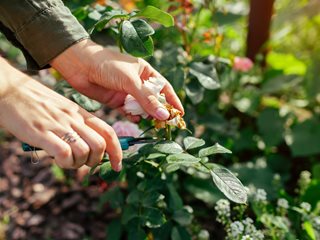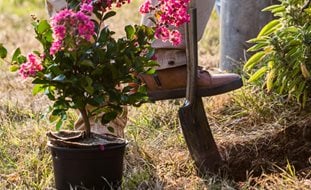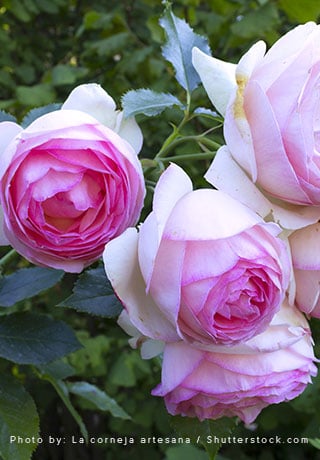Deadheading Roses: 7 Tips for Beautiful Blooms
For a long season of beautiful blooms, follow these guidelines for when and how to remove faded flowers.When roses are going strong in the summer, it’s easy to assume that the blooms will keep on coming with little effort on your part, other than fertilizing your roses regularly. While that’s true for some types of roses, others need occasional deadheading to coax more blooms and maintain the plant’s vigor.
Even if you think you’re a pro at deadheading the blooms of other flowering perennials and annuals, there are a few techniques specific to roses that are important to know. Here are tips for snipping the spent flowers from your prized roses to ensure a strong repeat performance.
7 TIPS FOR DEADHEADING ROSES
1. Know the type of roses you're working with.
Deadheading roses allows your plants to focus their energy on producing new blooms rather than forming rose hips, the berry-like fruits that develop after pollinated flowers fade. Most modern roses, including hybrid teas, floribundas, grandifloras, and climbers, are repeat flowering, so it's likely that the roses in your garden will benefit from regular deadheading to encourage rebloom.
If you are growing shrub roses, however, deadheading may not be necessary. Many newer varieties are self-cleaning (which means they don’t develop rose hips) and will rebloom continually throughout the growing season whether you deadhead or not, although plants will generally bloom more vigorously and look neater if the spent flowers are removed.
Learn more about the different types of garden roses.
2. Gather your tools.
For deadheading roses and other plants with stiff or woody stems, invest in a good pair of hand pruners (also called secateurs). Not only will this tool snip off flowers with ease, it will also make nice, clean cuts and minimize injury to plant stems. Just be sure to clean your pruners with a disinfectant before deadheading to prevent the spread of bacteria and fungi.
To avoid being pricked by thorns, a thick pair of gardening gloves is also essential. Another handy “tool” is a garden pail or weeding bucket. Use this to collect your spent blooms for disposal in your compost pile, rather than allowing the withered petals to scatter over the soil.
3. Remember the 5-leaflet rule.
If you look at the leaves surrounding your rose blooms, you’ll see one or two sets of leaves with three leaflets immediately below the flower. But as you go lower down on the stem, most of the leaves will have five leaflets. Generally, making your deadheading cuts right above the first five-leaflet set is best because that’s where the cane (the woody stem of the rose) is strong enough to support the new growth that will bear the next flower. Cutting back to a set of only three leaflets often results in weaker stems.
4. Look for an outward-facing bud eye.
Another generally accepted rule when deadheading roses is to make your cuts at an angle just above an outward-facing bud eye, a small dormant nodule at the base of the leaf that will sprout new growth after pruning. The reason for cutting above a bud eye that faces outward is to encourage new stems to grow in the same direction, rather than inward. This will help improve the shape of your plant and prevent the branches from rubbing or crossing.
5. Avoid removing healthy buds and blooms.
When deadheading roses with blooms that grow in clusters, such as floribundas, you’ll often notice that individual flowers in a cluster will begin to fade or wilt even though they’re surrounded by healthy buds or blooms. To remove the faded flowers, while leaving the adjoining blooms intact, carefully snip at the point where the flower joins the stem. Once all the flowers in the cluster are spent, you can then cut back to the first set of five leaflets.
6. Cut the stem at an angle.
Cutting rose stems at a 45-degree angle, rather than straight across, offers two benefits. First, the angled cut allows water from precipitation or overhead watering to run off quickly from the stem remaining on the plant, helping to prevent bacteria or fungi growth on exposed plant tissue.
If you are harvesting fresh roses for display in a vase (which, like deadheading, will also help to stimulate new blooms), cutting the stem at an angle improves the water uptake of the stem still attached to the flower because the entire surface area of the stem remains in contact with the water.
7. Don't remove too much foliage.
When deadheading roses, be sure to retain as much healthy foliage as possible. Foliage plays a critical role in photosynthesis, the process used by plants to convert sunlight into energy for producing food and, ultimately, more blooms. If you make your deadheading cuts above the first set of five leaflets, this will help to ensure that you don’t go overboard and remove more foliage than necessary.
DEADHEADING FAQS
What's the difference between deadheading and pruning roses?
Deadheading is a form of pruning, but is only intended to remove spent rose blossoms. Deadheading can be done as needed throughout the growing season after the plant starts flowering. Pruning is usually done annually, once plants are established, and involves the removal of canes to get rid of dead wood and any weak, thin growth. Learn more about pruning roses.
How often should roses be deadheaded?
You should deadhead regularly throughout the blooming season, which can vary depending on your climate and the type of rose you’re growing. Although it’s best to remove the faded flowers as soon as you notice them, the chore will be less tedious if you limit your deadheading sessions to every few days or once a week.
What happens if I neglect to remove withered rose blooms?
If you forget to deadhead your roses or simply don’t have the time, there’s no need to panic. Deadheading doesn’t make your roses healthier. It simply motivates them to rebloom faster. If you are growing rose plants that produce rose hips after the blooms fade, you may prefer not to deadhead at all. Many gardeners like to harvest the fruit for use in the kitchen or leave it on the plant to feed birds and other wildlife.
When should I stop deadheading roses?
In areas with cold winters, you should stop deadheading a few weeks before the first frost date to avoid encouraging new growth that may be damaged by early cold temperatures and to allow the plant to produce rose hips, which provide good winter interest. In warmer climates, instead of deadheading the last blooms of the season, simply remove the petals and allow the rose hips to form, which will tell the plant that it’s time for winter dormancy.
Should I remove rose buds that fail to open?
If there’s anything sadder than a rose bloom past its prime, it’s a rosebud that fails to open in the first place. This problem, called rose balling, occurs when the outer petals of the bud become soaked by rain or overhead watering and then get scorched by the sun before they dry out, fusing the petals together and preventing the bud from opening. Although the buds will eventually wither and drop off, they should be removed by the same techniques used for deadheading to prevent the development of botrytis blight, commonly known as gray mold.





